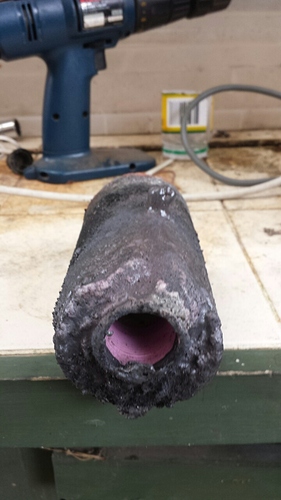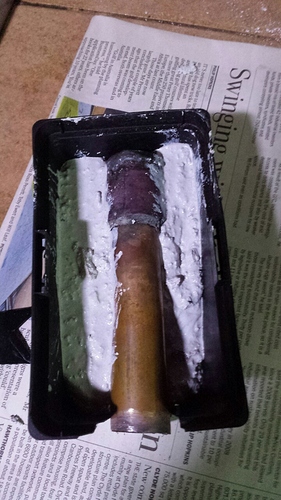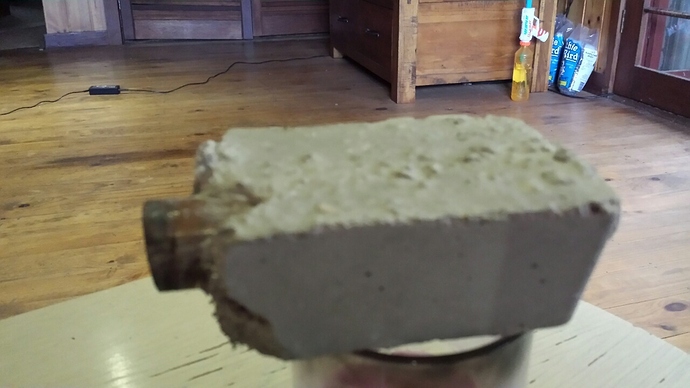Keep in mind that we are not dealing with melting, but with catastrophic oxidation. I think a good reaction temperature is around 1000C, which is well below the melting temperature of a standard pipe nipple, so melting is not our big problem. Temperature is definitely a factor, but only because it is accompanied by air flowing around the hot tip of our nozzle. The heat is helping the oxygen in the airflow to gobble up our nozzles.
Hi Kyle ,
What Don has done with his tig nozzle would be the quickest and cheapest way to get decent run time out of your nozzle .
Bruce is also spot on with what he is telling us its more of a oxidation problem than a melting problem when using high temp steel .
On my nozzle I don’t screw the pipe into the nozzle but just rest it on top and then pour refractory cement around the nozzle and the pipe , sorry I couldn’t lay my hands on a recent picture , but here are some before and after one’s that’s had at least 30 hour’s of run with no water drip or exhaust return , and the nozzle still looks as good as new , the refractory cement has taken most of the damage
Dave
Bruce
You spoke a copper nozzle to dissipate heat ( another page)
Can you elaborate on this subject?
Hi Trigaux ,
I think a few people have tried or used copper for a nozzle with the same melting or oxidation results as for high carbon steel .
The copper tube I used was from air conditioning trade and had a slightly thicker wall , but still melted away pretty quickly , I then started using copper tube instead of steel pipe nipples when I cast my TIG nozzles in refractory cement as it carried the heat away better and also turned my water drip into steam a lot faster , I found an old picture of the very first attempt I made , this worked well ( about 40 hours run time) enough for me to carry on experimenting with other nozzle shapes and sizes .
Dave
I can’t remember who posted it, but I read a forum post about using copper tuyeres for authentic viking style iron smelting. If the pipe wall was at least 1/4 inch thick and extended beyond the outside wall of the smelter to dissipate heat it had a long life.
I made a nozzle by drilling a 5/8 hole through a 1-1/8 inch round copper bar about a foot long which took a lot of work. I ran it in my gasifier for a few hours with water drip and about 20 minutes with a full blast of dry air and no EGR. Only a slight green patina and no corrosion. I then came across a research paper about nickel plating copper to control oxidation. Supposedly plating reduced oxidation to 1/20th the rate for unplated copper in high temp environments. I am currently building a charcoal gasifier for a 1976 MGB which will have a 1-1/2" OD X 1" ID nickel plated copper tuyere. I hope to have it ready to fire up by mid May so I will report on the results.
Bruce, Didn’t you and Gary G try a copper nozzle last year at Argos?
Yes, Gary had a thick walled (1/8" thick, I think) copper pipe. He tried it in his SimpleFier at Argos without EGR or water drip and it corroded just like steel. I’m hoping that the 1/4" minimum thickness is the critical factor. Also, it is my intention to keep the reaction temperature to a maximum of 1000C.
Good morning Bruce.
If all works well will you be driving it to Argos in May ?
Bruce, do you intend to automated control of temperature?
(Pdi, thermocouple and solenoid)
Thierry
Wayne,
I’m sorry to say that I won’t make it to Argos this year. It was my plan to be there, and that dream helped get me through the winter. My wife asked a few gentle questions about the distance from New Hampshire, the condition of our vehicles, my energy and when we might see our grandbabies.
I still hope to post pictures and video before Argos to keep the friendly charcoal vs. wood rivalry going. Wood gassers have the upper hand on this one. I figure that I would need about 300 gallons of charcoal each way to make the drive. I was going to tow it to my brother’s place about 3 hours from Argos and drive in from there. My old '93 chevy van is about to give up the ghost.
Thierry,
My plan is to use a thermocouple to monitor the reaction temperature and manually adjust exhaust gas recirculation. If this little 1800 cc is gutless, I have some pistons that will take the CR from its current 8:1 up to 12:1 .
Dave - Thanks for posting pics of your nozzle. That doesn’t look like it would be too hard to make. I am surprised that the pipe inside doesn’t expand fast enough to crack the refractory cement.
Don - That’s a nice looking nozzle, and looks pretty easy to make. I notice that there appears to be a gap in the stainless heat shield on the back side. What is that for?
You mention some slits in the nozzle. I don’t see them.
Are you observing any signs of erosion yet?
I don’t really understand the nuances of high temp. oxidation, melting, burning, sulfidation, corrosion, etc. I have been trying to study it a little bit since I saw your post, but so far don’t have a handle on it.
I found a scholarly article on the high temp. oxidation of steel and read about the study they conducted. It appeared to me that the “oxidation” (scale formation) that they were observing was proceeding much more slowly than what we are seeing, at about 1100 C.
I found another article that said steel can begin to lose mechanical strength at temperatures as low as 500 C.
So maybe we are observing a combination of slumping, oxidation, and maybe even a little melting?
I don’t know.
I have the hypocrisy disease. I affirm and pontificate far beyond my understanding. I was confused about the “melting” of my nozzles when I was operating at temperatures below the melting point of my nozzle material. Then I came across the magic phrase “catastrophic oxidation” and that made sense. Now I throw that term around as if i know what I’m talking about. Perhaps someone who really understands this stuff can enlighten us.
Here is an article that is not too technical that gives a good practical overview of the various corrosion processes in metals at high temperature.
It appears to me that the moral of this story is that it is probably better to quit trying to “fight city hall” and move on to some sort of ceramics in the environment we are trying to deal with.
Kyle, the slits are in the turned down pipe nipple that the nozzle fits over. The stainless sleeve was not big enough to make a complete circle aound so I make sure that the gap is at the bottom when it is in place so that it won’t catch and hold char. I have not taken the nozzle out yet after about 20 hours use but everything looks good through the air inlet and it starts and runs like it did the first time.
Bruce, you say
"If this little 1800 cc is gutless, I have some pistons that will take the CR from its current 8:1 up to 12:1 "
you increase the compression engine with pistons modified by yourself
Or it is a kit sold by the engine manufacturer ?
Don - Which TIG tips are you using?
The ones that Dave recommended would have to ship from Australia.
I would prefer to obtain something domestically.



